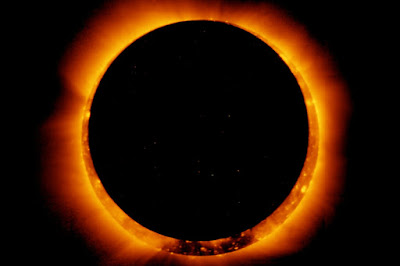So-called annular eclipses occur when the Moon - passing between Earth and the Sun - is not quite close enough to our planet to completely obscure sunlight, leaving a thin ring of the solar disc visible
Solar Eclipse 2020 marked one of only 5 such instances where a maximum solar eclipse was visible from India in a timeframe of the next 100 years. The annular belt of the eclipse in India passed through cities like Joshimath and Dehradun in Uttrakhand, Sirsa in Haryana, parts of Rajasthan, but the eclipse was witnessed from every corner of the country.
India witnessed the magnificent 'Ring of Fire' and saw the skies turn dark as the Moon overshadowed the mighty Sun. Delhites were left disappointed since overcast weather deprived them of the historic sight.
 |
Partial solar eclipse from Kathmandu, Nepal |
What is Solar Eclipse?
A solar eclipse is witnessed when the moon passes between the Earth and the Sun. During the Surya Grahan phenomenon, the image of the Sun is totally or partly obscured. In the case of an annual solar eclipse, the moon's apparent diameter is smaller than that of the Sun. The phenomenon also blocks most of the sunlight, causing the Sun to look like an annulus (ring). An annular eclipse appears as a partial eclipse over a region of the Earth thousands of kilometers wide.
 |
| People view the eclipse from scaffolding in Kuwait |
Astrologers said it is a fourth super rare hybrid eclipse which is a mix between an annular and total solar eclipse. Areas like Hyderabad, Chennai, Bhubaneshwar, Kolkata, Lucknow, Mumbai, Delhi, Patna, Shillong and more witnessed a partial phase of the annular solar eclipse from 9 a.m.
 |
| A girl observes the solar eclipse from the Mahanakhon Skywalk glass tray, Bangkok, Thailand |
An annular solar eclipse occurs when the apparent size of the moon is only slightly less than the Sun's - or the Moon almost covers the Sun - leaving only the outer rim of the Sun uncovered, and hence giving the appearance of a "ring of fire" or as a necklace of pearls. The ring this time was very thin, as the Moon covered over 98.8 per cent of the Sun, making it the deepest annular eclipse of the century in India.
Courtesy: theguardian, livemint, indiaTV











